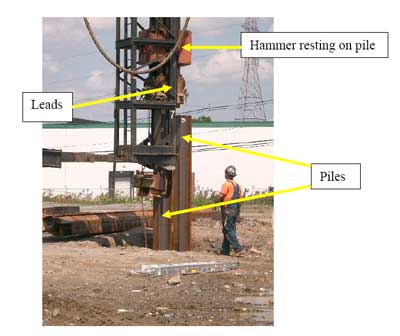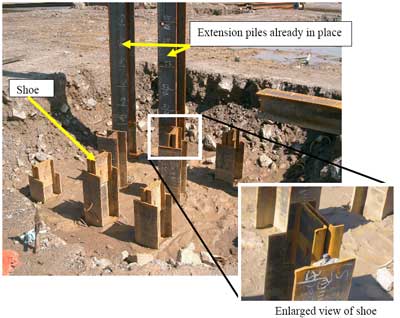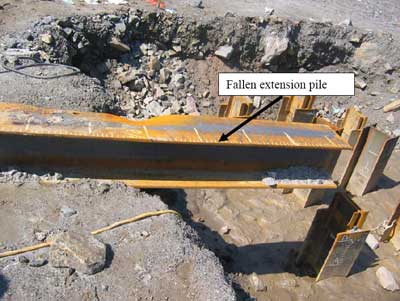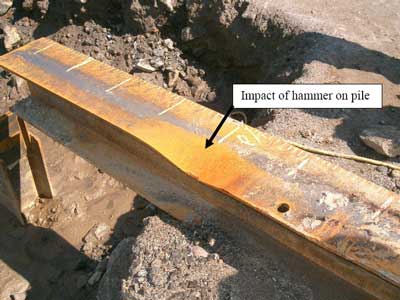43-Year-Old Construction Foreman Dies After Struck by Steel Pile
New Jersey Case Report: 06NJ078
Report Date: March 12, 2008
Summary
On August 29, 2006, a 43-year-old male construction foreman was killed when he was struck by a falling steel I-beam pile. The victim worked for a construction company in northern New Jersey. On the day of the incident, the victim and four other workers were in the process of piledriving steel I-beam piles into several pits (each containing either three or eight piles) at the construction site of a large parking garage. The victim’s job was to stand in the pit and guide the beam that was being hoisted by the pile driver (which functions as a crane and a hammer) to the appropriate position to be hammered. While the victim was guiding the pile, before it was properly located, the hammer dropped from its upper position. Since the pile was not in the proper location, the hammer struck the pile on its side, instead of the top. The fatal injury occurred when the beam then fell to the side, striking the victim. NJ FACE investigators recommend following these safety guidelines to prevent similar incidents:
- Employers should ensure that pile driver operators are properly trained on the safe operation of pile driving equipment.
- Employers should ensure that pile driver operators are periodically reevaluated on the safe operation of pile driving equipment.
- A safety and health plan based on a job hazard analysis should be developed and followed.
- Employers should incorporate specific excavation procedures into the safety and health plan.
Introduction
On August 29, 2006, a federal OSHA compliance officer notified NJ FACE staff of the death of a 43-year-old construction foreman who was killed after being struck by a steel I-beam pile at a construction site. A FACE investigator conferred with the compliance officer, and arranged to conduct a concurrent investigation, which took place on September 7, 2006. During the visit, FACE investigators were permitted to participate in the OSHA witness interviews and to examine both the pit where the victim was fatally injured and a pile driver similar to that involved in the incident. The area and the pile driver were photographed. Additional information was obtained from the police report, the medical examiner’s report, and the OSHA investigation file.
The victim’s employer was a general construction company for which he had worked for 23 years. The company employed 15 workers; seven were working on the site the day of the incident, and four were working in the particular pit where the incident occurred. Employee training was conducted through the Union of Operating Engineers Local Training Center, and on site by the employer.
Back to Top
Investigation
The incident occurred at an expansive, open construction site in an urban area of New Jersey. The pit where the victim was injured was a 12-by-12-foot area, approximately 50 inches deep. Several pits had already been completed including (both 8-pile and 3-pile pits). After the piles were driven, concrete was to be poured into the pit to form the foundation for a 4 ½ story parking garage that would service the apartment buildings that were also to be built on the site.
A crane-supported pneumatic pile driver was used to sink the piles. This device used air pressure to raise an 11,200-pound hammer onto the top of a pile. The hammer moved on steel tracks (leads), which are longer in length than the piles. The piles were lifted vertically into position with the crane over the area where they were to be driven. To raise a pile into the leads, the crane operator lowered the hammer close to the ground where a worker connected nylon straps. As the hammer was raised, the pile was then lifted with it until fully upright in the leads (See Figure 1).
 |
|
Figure 1: Pile driver at incident site. |
When the pile was not long enough, extensions were required. In order to add an extension, a shoe (the piece that interlocks with the extension pile to hold it in place) was first welded to the end of the existing pile (see Figure 2). Then the extension pile (a 10 ft. pile in this case) was hoisted and moved via the crane to a point where it rested on the shoe. The crew in the pit ensured this position by manually adjusting the extension pile’s position. After the pit crew and spotter approved the position of the extension pile, the hammer was gently lowered to rest on top of the pile to hold it in place, and the extension pile was welded to the shoe. After the welding was completed, the extended pile was hammered to the desired depth by the pile driver.

|
|
Figure 2: Pit with two extension piles in place and other piles with shoes welded. |
The incident occurred at approximately 9:45 AM on Tuesday, August 29, 2006, a damp and rainy day. The job started at 7:00 AM, and a crew of four began “knitting” (welding) extension piles to the first of eight to be completed in the pit on that day; no hammering was to be done on this day. Just prior to the 9:15 AM break, the crew successfully knitted the second extension pile. Work resumed at approximately 9:30 AM, and the incident occurred shortly thereafter.
It is not exactly clear what happened, therefore the following two versions from the crane operator and the spotter, respectively, are presented.
Version #1: According to the crane operator, the crew was knitting a 10-foot extension pile onto an existing pile. He lifted the extension pile from the ground with the crane and placed it on top of the existing pile. Once in place, the victim, who was in the pit in order to manually position the pile, signaled with two fingers to the crane operator (a two-finger signal indicates “operate the hammer;” a one-finger signal indicates “operate the crane”). The crane operator then gently lowered the hammer onto the extension pile and, according to the operator, it supported the weight of the hammer. The crane inadvertently swung to the right, and the victim then instructed the operator to “bump” (nudge) it back to the left. The operator bumped the crane back, and at that moment, the extension “spit” out. According to the crane operator, the victim tried to move, but fell.
Version #2: According to the spotter, the setting of the extension proceeded correctly, as per the operator. The victim was ensuring that the pile was in position. Then the leads of the crane swung causing the beam to tilt over to one side (the victim’s side), positioning the extension pile directly over the victim. According to the spotter, the normal practice would then be to swing the extension back and straighten it out. However, at this point the hammer was inadvertently dropped, and it hit the misaligned extension pile (see Figure 3-4), which caused it to fall.
The pile fell on top of the victim. Other workers attempted to provide assistance while one worker called 911. Police and rescue workers responded, and the victim was pronounced dead at the scene via telemetry.
 |
 |
|
Figure 4: Pile as it rested after crushing victim. Note the muddy conditions.
|
Back to Top
Recommendations/Discussion
Recommendation #1: Employers should ensure that pile driver operators are properly trained on the safe operation of pile driving equipment.
Discussion: All pile driver operators should be properly trained in the safe use of the equipment. Employers should provide classroom and hands-on training to the operators, and training must be specific to the worksite and equipment used. Training must be taught by a competent person, and operators should be certified as having passed the training.
Recommendation #2: Employers should ensure that pile driver operators are periodically reevaluated on the safe operation of pile driving equipment.
Discussion: Operators should be periodically reevaluated, and should demonstrate the ability to safely operate the machine under the supervision of the trainer. NJ FACE recommends reevaluation through training centers such as the Union of Operating Engineer Local Training Center. The OSHA regulation applicable to pile driving equipment can be found in 29 CFR 1910.603, and additional information on other relevant OSHA regulations is also available (See Appendix).
Recommendation #3: A safety and health plan based on a job hazard analysis should be developed and followed.
Discussion: Employers should conduct a job hazard analysis, with the participation of employees, of all work areas and job tasks. A job hazard analysis should begin by reviewing the work activities for which the employee is responsible, and the equipment that is needed. Each task is further examined for mechanical, electrical, chemical, or any other hazard the worker may encounter. Additional information on conducting a job hazard analysis is included in the Appendix.
Recommendation #4: Employers should incorporate specific excavation procedures into the safety and health plan.
Discussion: Specific safety and health issues associated with excavation need to be addressed in accordance with 29 CFR 1926. 651. Specifically, daily inspections of excavations should be made by a competent person for evidence of hazardous situations, and inspections are to be conducted after every rainstorm. In this case, the conditions at the bottom of the pit were muddy (see Figure 4), and could have hindered the egress of the victim.
Appendix
Recommended Resources
It is extremely important that employers obtain accurate information on health, safety, and applicable OSHA standards. NJ FACE recommends the following sources of information which should help both employers and employees:
U.S. Department of Labor, Occupational Safety & Health Administration (OSHA)
Federal OSHA will provide information on safety and health standards on request. OSHA has four area offices in New Jersey that cover the following counties:
Hunterdon, Middlesex, Somerset, Union, and Warren counties
Telephone: (732) 750-3270
Essex, Hudson, Morris, and Sussex counties
Telephone: (973) 263-1003
Bergen and Passaic counties
Telephone: (201) 288-1700
Atlantic, Burlington, Cape May, Camden, Cumberland, Gloucester, Mercer, Monmouth, Ocean, and Salem counties
Telephone: (856) 757-5181
Federal OSHA
Web site: https://www.osha.gov/external icon
New Jersey Public Employees Occupational Safety and Health (PEOSH) Program
The PEOSH Act covers all NJ state, county, and municipal employees. Two state departments administer the act; the NJ Department of Labor and Workforce Development (NJDLWD), which investigates safety hazards, and the NJ Department of Health and Senior Services (NJDHSS), which investigates health hazards. PEOSH has information available that may also benefit private employers.
NJDLWD, Office of Public Employees Safety
Telephone: (609) 633-3896
Web site: http://lwd.dol.state.nj.us/lsse/employer/Public_Employees_OSH.htmlexternal icon
NJDHSS, Public Employees Occupational Safety & Health Program
Telephone: (609) 984-1863
Web site: http://www.state.nj.us/health/eoh/peoshweb/external icon
On-site Consultation for Public Employers
Telephone: (609) 984-1863 or (609) 633-2587
Web site: www.state.nj.us/health/eoh/peoshweb/peoshcon.htmexternal icon
New Jersey Department of Labor and Workforce Development, Occupational Safety and Health On-Site Consultation Program
This program provides free advice to private businesses on improving safety and health in the workplace and complying with OSHA standards.
Telephone: (609) 984-0785
Web site: http://lwd.dol.state.nj.us/labor/lsse/employer/peosh_consultation.htmlexternal icon
New Jersey State Safety Council
The NJ State Safety Council provides a variety of courses on work-related safety. There is a charge for the seminars.
Telephone: (908) 272-7712.
Web site: http://www.njsafety.orgexternal icon
Internet Resources
Other useful internet sites for occupational safety and health information:
- CDC/NIOSH – https://www.cdc.gov/niosh/
- Employment Laws Assistance for Workers and Small Businesses – http://www.dol.gov/elaws/external icon
- National Safety Council – http://www.nsc.org/Pages/Home.aspxexternal icon (Link updated 11/17/2009)
- American National Standards Institute (ANSI) – http://www.ansi.orgexternal icon
- Product recall information – http://www.recalls.govexternal icon
- NJDHSS FACE reports – http://www.state.nj.us/health/eoh/survweb/face.htmexternal icon
- CDC/NIOSH FACE – https://www.cdc.gov/niosh/face/
Reference
Job Hazard Analysis. US Department of Labor Publication # OSHA-3071, 1998 (revised).
USDOL, OSHA/OICA Publications, PO Box 37535, Washington DC 20013-7535.
New Jersey FACE Program
Fatality Assessment and Control Evaluation (FACE) Project
Investigation # 06-NJ-063
Staff members of the New Jersey Department of Health and Senior Services, Occupational Health Service, perform FACE investigations when there is a report of a targeted work-related fatal injury. The goal of FACE is to prevent fatal work injuries by studying the work environment, the worker, the task and tools the worker was using, the energy exchange resulting in the fatal injury, and the role of management in controlling how these factors interact. FACE gathers information from multiple sources that may include interviews of employers, workers, and other investigators; examination of the fatality site and related equipment; and reviewing OSHA, police, and medical examiner reports, employer safety procedures, and training plans. The FACE program does not determine fault or place blame on employers or individual workers. Findings are summarized in narrative investigation reports that include recommendations for preventing similar events. All names and other identifiers are removed from FACE reports and other data to protect the confidentiality of those who participate in the program.
NIOSH-funded state-based FACE Programs include: California, Iowa, Kentucky, Massachusetts, Michigan, New Jersey, New York, Oregon, and Washington. Please visit the NJ FACE website at www.state.nj.us/health/eoh/survweb/face.htmexternal icon or the CDC/NIOSH FACE website at www.cdc.gov/niosh/face for more information.
This NJ FACE report is supported by Cooperative Agreement # 5 U60 OH00845 from the Centers for Disease Control and Prevention (CDC). Its contents are solely the responsibility of the authors and do not necessarily represent the official views of the CDC.
To contact New Jersey State FACE program personnel regarding State-based FACE reports, please use information listed on the Contact Sheet on the NIOSH FACE web site. Please contact In-house FACE program personnel regarding In-house FACE reports and to gain assistance when State-FACE program personnel cannot be reached.

